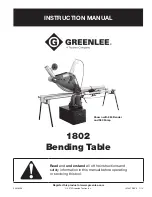
FEED THE WORKPIECE
• This jointer machine is designed to process natural
wood fiber only . Never use plastics, metal, laminated
articles, particle board, plywood, MDF or other synthetic
materials on this machine.
• Never process a workpiece that is shorter than 10”,
narrower than 3/4", or less than 1/2" thick. As this can
cause severe injuries to your hands by getting into the
rotating cutterhead accidentally.
• Never feed a workpiece that has large knots, loose
knots, or foreignbodies like wires, nails, staples, to
prevent kickback, blade damage, or injuries to the
machine operator.
• To feed the workpiece through the cutterhead, hold
the board firmly down on the infeed table and against
the fence. Use Hold Down Block if indicated, see next
section.
• Keep fingers close together to prevent injury.
• Feed the workpiece toward the cutterhead slowly at a
constant speed while holding the workpiece firmly. Avoid
any stop during the process as this may cause an
uneven step on the workpiece.
• Depending on the length of workpiece, you may need
to alternate your hands during the process. As soon as
the trailing hand passes the cutterhead, move the
leading hand to the back of the trailing hand. Now the
trailing hand becomes the leading hand and the
leading hand becomes the trailing hand. Repeat this
until the entire workpiece passes through the
cuttinghead.
• While alternating your hands, try to keep firm control of
the workpiece and keep the feed speed constant.
• Surface plane on the jointer – The concave face to the
workpiece is the surface planed flat with the jointer.
• Edge jointer on the jointer – The concave edge of the
workpiece is jointed flat with the jointer.
USE HOLD DOWN/PUSH BLOCKS
• Use Hold Down Block or Push Blocks when process any
workpiece that is lower than the fence height.
• Position the Hold Down/Push Blocks on the top of the
workpiece and make sure there is good contact and firm
control during the process. Push Hold Down/Push
Blocks down firmly against the workpiece on the table.
Proceed to feed the workpiece toward cutterhead.
• When jointing or planing a workpiece narrower than the
push blocks, tilt the push blocks so that it clears the
cutterhead guard while feeding.
BEVEL AND CHAMFER
The fence can be set from 45° inward to 45° degree
outward. Beveling is cutting the entire edge of a workpiece
at an angle. Chamfering is removing only a small corner of
the edge. Both can be achieved by appropriately adjusting
the Fence Angel and Depth of Cut.
Figure 18 - Feeding board
Figure 19 - Guiding Workpiece
Figure 21 - Feeding with Push Blocks
Figure 22 - Beveling and Chamfering
OPERA
TION
9
Chamfer Edge
Bevel Edge





































